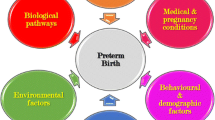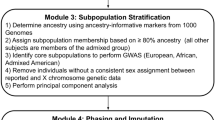Abstract
Preterm birth (PTB) is a major global public health concern. However, little is known about the pathophysiology of spontaneous idiopathic PTB. We tested the hypothesis that rare variants in families would target specific genes and pathways that contribute to PTB risk in the general population. Whole-exome sequencing was performed on 10 PTB mothers from densely affected families including two mother–daughter pairs. We identified novel variants shared between the two mother–daughter pairs when compared to a 1000 Genomes Project background exome file and investigated these genes for pathway aggregation using the Kyoto Encyclopedia of Genes and Genomes (KEGG). Genes in enriched pathways were then surveyed in the other six PTB exomes and tested for association in a larger number of nuclear families. The KEGG complement and coagulation cascade was one of the most enriched pathways in our two mother–daughter pairs. When the six genes found in this pathway (CFH, CR1, F13B, F5, CR2, and C4BPA) were examined for novel missense variants, half of all the exomes harbored at least one. Association analysis of variants in these six gene regions in nuclear families from Finland (237 cases and 328 controls) found statistically significant associations after multiple test corrections in three CR1 SNPs; the strongest in an exonic missense SNP, rs6691117, p value = 6.91e−5, OR = 1.71. Our results demonstrate the importance of the complement and coagulation cascades in the pathophysiology of PTB, and suggest potential screening and intervention approaches to prevent prematurity that target this pathway.


Similar content being viewed by others
References
Adzhubei IA, Schmidt S, Peshkin L, Ramensky VE, Gerasimova A, Bork P, Kondrashov AS, Sunyaev SR (2010) A method and server for predicting damaging missense mutations. Nat Methods 7(4):248–249. doi:10.1038/nmeth0410-248
Chaudhari BP, Plunkett J, Ratajczak CK, Shen TT, DeFranco EA, Muglia LJ (2008) The genetics of birth timing: insights into a fundamental component of human development. Clin Genet 74(6):493–501. doi:10.1111/j.1399-0004.2008.01124.x
Hao K, Wang X, Niu T, Xu X, Li A, Chang W, Wang L, Li G, Laird N, Xu X (2004) A candidate gene association study on preterm delivery: application of high-throughput genotyping technology and advanced statistical methods. Hum Mol Genet 13(7):683–691. doi:10.1093/hmg/ddh091
Härtel C, von Otte S, Koch J, Ahrens P, Kattner E, Segerer H, Möller J, Diedrich K, Göpel W (2005) Polymorphisms of haemostasis genes as risk factors for preterm delivery. Thromb Haemost 94(1):88–92. doi:10.1267/THRO05010088
Howson CP, Kinney MV, Lawn J (2012) March of Dimes, PMNCH, save the children, WHO. Born too soon: the global action report on preterm birth. World Health Organization, Geneva
Imrie H, McGonigle T, Liu D, Jones D (1996) Reduction in erythrocyte complement receptor 1 (CR1, CD35) and decay accelerating factor (DAF, CD55) during normal pregnancy. J Reprod Immunol 31(3):221–227
Kanehisa M, Goto S (2000) KEGG: kyoto encyclopedia of genes and genomes. Nucleic Acids Res 28(1):27–30
Kullo IJ, Ding K, Shameer K, McCarty CA, Jarvik GP, Denny JC, Ritchie MD, Ye Z, Crosslin DR, Chisholm RL, Manolio TA, Chute CG (2011) Complement receptor 1 gene variants are associated with erythrocyte sedimentation rate. Am J Hum Genet 89(1):131–138. doi:10.1016/j.ajhg.2011.05.019
Laird NM, Horvath S, Xu X (2000) Implementing a unified approach to family-based tests of association. Genet Epidemiol 19(Suppl 1):S36–S42
Lockwood CJ, Kuczynski E (2001) Risk stratification and pathological mechanisms in preterm delivery. Paediatr Perinat Epidemiol 15(Suppl 2):78–89
Lynch AM, Gibbs RS, Murphy JR, Byers T, Neville MC, Giclas PC, Salmon JE, Van Hecke TM, Holers VM (2008) Complement activation fragment Bb in early pregnancy and spontaneous preterm birth. Am J Obstet Gynecol 199 (4):354 e351–358. doi:10.1016/j.ajog.2008.07.044
Lynch AM, Gibbs RS, Murphy JR, Giclas PC, Salmon JE, Holers VM (2011) Early elevations of the complement activation fragment C3a and adverse pregnancy outcomes. Obstet Gynecol 117(1):75–83. doi:10.1097/AOG.0b013e3181fc3afa
MacArthur DG, Balasubramanian S, Frankish A, Huang N, Morris J, Walter K, Jostins L, Habegger L, Pickrell JK, Montgomery SB, Albers CA, Zhang ZD, Conrad DF, Lunter G, Zheng H, Ayub Q, DePristo MA, Banks E, Hu M, Handsaker RE, Rosenfeld JA, Fromer M, Jin M, Mu XJ, Khurana E, Ye K, Kay M, Saunders GI, Suner M–M, Hunt T, Barnes IHA, Amid C, Carvalho-Silva DR, Bignell AH, Snow C, Yngvadottir B, Bumpstead S, Cooper DN, Xue Y, Romero IG, Consortium GP, Wang J, Li Y, Gibbs RA, Mccarroll SA, Dermitzakis ET, Pritchard JK, Barrett JC, Harrow J, Hurles ME, Gerstein MB, Tyler-Smith C (2012) A systematic survey of loss-of-function variants in human protein-coding genes. Science (New York, NY) 335 (6070):823–828. doi:10.1126/science.1215040
McKenna A, Hanna M, Banks E, Sivachenko A, Cibulskis K, Kernytsky A, Garimella K, Altshuler D, Gabriel S, Daly M, DePristo MA (2010) The genome analysis toolkit: a MapReduce framework for analyzing next-generation DNA sequencing data. Genome Res 20(9):1297–1303. doi:10.1101/gr.107524.110
Ng PC, Henikoff S (2003) SIFT: predicting amino acid changes that affect protein function. Nucleic Acids Res 31(13):3812–3814
Ng SB, Buckingham KJ, Lee C, Bigham AW, Tabor HK, Dent KM, Huff CD, Shannon PT, Jabs EW, Nickerson DA, Shendure J, Bamshad MJ (2010) Exome sequencing identifies the cause of a mendelian disorder. Nat Genet 42(1):30–35. doi:10.1038/ng.499
O’Roak BJ, Deriziotis P, Lee C, Vives L, Schwartz JJ, Girirajan S, Karakoc E, Mackenzie AP, Ng SB, Baker C, Rieder MJ, Nickerson DA, Bernier R, Fisher SE, Shendure J, Eichler EE (2011) Exome sequencing in sporadic autism spectrum disorders identifies severe de novo mutations. Nat Genet 43(6):585–589. doi:10.1038/ng.835
Plunkett J, Muglia LJ (2008) Genetic contributions to preterm birth: implications from epidemiological and genetic association studies. Ann Med 40(3):167–195. doi:10.1080/07853890701806181
Plunkett J, Feitosa MF, Trusgnich M, Wangler MF, Palomar L, Kistka ZA-F, DeFranco EA, Shen TT, Stormo AED, Puttonen H, Hallman M, Haataja R, Luukkonen A, Fellman V, Peltonen L, Palotie A, Daw EW, An P, Teramo K, Borecki I, Muglia LJ (2009) Mother’s genome or maternally-inherited genes acting in the fetus influence gestational age in familial preterm birth. Hum Hered 68(3):209–219. doi:10.1159/000224641
Plunkett J, Doniger S, Orabona G, Morgan T, Haataja R, Hallman M, Puttonen H, Menon R, Kuczynski E, Norwitz E, Snegovskikh V, Palotie A, Peltonen L, Fellman V, DeFranco EA, Chaudhari BP, McGregor TL, McElroy JJ, Oetjens MT, Teramo K, Borecki I, Fay J, Muglia L (2011) An evolutionary genomic approach to identify genes involved in human birth timing. PLoS Genet 7(4):e1001365. doi:10.1371/journal.pgen.1001365.t002
Ricklin D, Lambris JD (2007) Complement-targeted therapeutics. Nat Biotechnol 25(11):1265–1275. doi:10.1038/nbt1342
Soto E, Romero R, Richani K, Espinoza J, Nien JK, Chaiworapongsa T, Santolaya-Forgas J, Edwin SS, Mazor M (2005) Anaphylatoxins in preterm and term labor. J Perinat Med 33(4):306–313. doi:10.1515/JPM.2005.051
Vaisbuch E, Romero R, Erez O, Mazaki-Tovi S, Kusanovic JP, Soto E, Dong Z, Chaiworapongsa T, Kim SK, Ogge G, Pacora P, Yeo L, Hassan SS (2010) Activation of the alternative pathway of complement is a feature of pre-term parturition but not of spontaneous labor at term. Am J Reproductive immunology (New York, NY: 1989) 63(4):318–330. doi:10.1111/j.1600-0897.2009.00800.x
van den Broe NR, Letsky EA (2001) Pregnancy and the erythrocyte sedimentation rate. BJOG : Int J Obstet Gynaecol 108(11):1164–1167
Velez DR, Fortunato SJ, Thorsen P, Lombardi SJ, Williams SM, Menon R (2008) Preterm birth in Caucasians is associated with coagulation and inflammation pathway gene variants. PLoS ONE 3(9):e3283. doi:10.1371/journal.pone.0003283
Wang Y, Rollins SA, Madri JA, Matis LA (1995) Anti-C5 monoclonal antibody therapy prevents collagen-induced arthritis and ameliorates established disease. Proc Natl Acad Sci USA 92(19):8955–8959
Wang X, Zuckerman B, Kaufman G, Wise P, Hill M, Niu T, Ryan L, Wu D, Xu X (2001) Molecular epidemiology of preterm delivery: methodology and challenges. Paediatr Perinat Epidemiol 15(Suppl 2):63–77
Weisman HF, Bartow T, Leppo MK, Marsh HC, Carson GR, Concino MF, Boyle MP, Roux KH, Weisfeldt ML, Fearon DT (1990) Soluble human complement receptor type 1: in vivo inhibitor of complement suppressing post-ischemic myocardial inflammation and necrosis. Science (New York, NY) 249(4965):146–151
Yandell M, Huff C, Hu H, Singleton M, Moore B, Xing J, Jorde LB, Reese MG (2011) A probabilistic disease-gene finder for personal genomes. Genome Res 21(9):1529–1542. doi:10.1101/gr.123158.111
Zareba K (2007) Eculizumab: a novel therapy for paroxysmal nocturnal hemoglobinuria. Drugs Today 43:539–546
Züchner S, Dallman J, Wen R, Beecham G, Naj A, Farooq A, Kohli MA, Whitehead PL, Hulme W, Konidari I, Edwards YJK, Cai G, Peter I, Seo D, Buxbaum JD, Haines JL, Blanton S, Young J, Alfonso E, Vance JM, Lam BL, Peričak-Vance MA (2011) Whole-exome sequencing links a variant in DHDDS to retinitis pigmentosa. Am J Hum Genet 88(2):201–206. doi:10.1016/j.ajhg.2011.01.001
Acknowledgments
This work was supported by Grants from the March of Dimes (LJM and JCM) and NIH (T32 GM07347 to JJM; R01 HD52953 to JCM; and T32 HD068256 to CEG).
Conflict of interest
The authors declare that they have no conflict of interest
Author information
Authors and Affiliations
Corresponding author
Electronic supplementary material
Below is the link to the electronic supplementary material.
Supplemental Table 1. VAAST genes with most significant p values in family 1168 sorted by rank
Supplemental Table 2. VAAST genes with most significant p values in family 1281 sorted by rank
Supplemental Table 3. KEGG pathways with more than three genes from the list of the most significant p value genes for family 1168
Supplemental Table 4. KEGG pathways that contained more than three genes from the most significant p value genes for family 1281
Supplemental Table 5. Novel missense variants in the six other exomes for the six complement and coagulation cascade genes identified by VAAST (for the PolyPhen-2 prediction the HumDiv algorithm was used).
Supplemental Table 6. Complete unadjusted and adjusted additive logistic regression association results for Finnish mothers’ complement and coagulation factor exome SNPs on Illumina arrays sorted by adjusted p value. The gene listed is that in which the SNP is located and in parentheses is the VAAST gene; the SNP was selected to interrogate within the 10 kb 5′ and 3′ buffer.
Supplemental Table 7. Complete unadjusted additive logistic association results for Finnish mothers’ Affymetrix 6.0 SNP arrays sorted by p value. The gene listed is that in which the SNP is located and in parentheses is the VAAST gene the SNP was selected to interrogate within the 10 kb 5′ and 3′ buffer.
Rights and permissions
About this article
Cite this article
McElroy, J.J., Gutman, C.E., Shaffer, C.M. et al. Maternal coding variants in complement receptor 1 and spontaneous idiopathic preterm birth. Hum Genet 132, 935–942 (2013). https://doi.org/10.1007/s00439-013-1304-5
Received:
Accepted:
Published:
Issue Date:
DOI: https://doi.org/10.1007/s00439-013-1304-5




